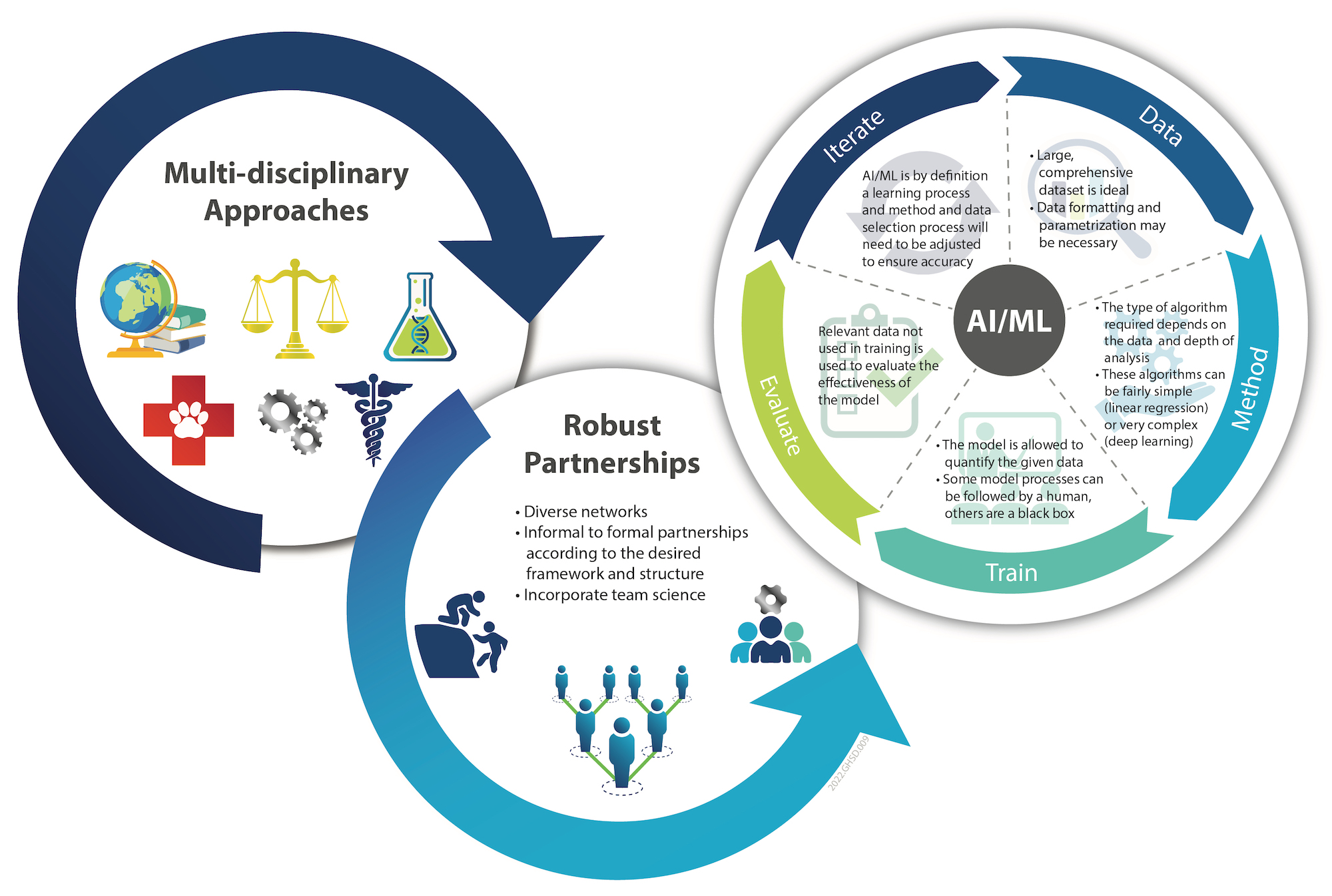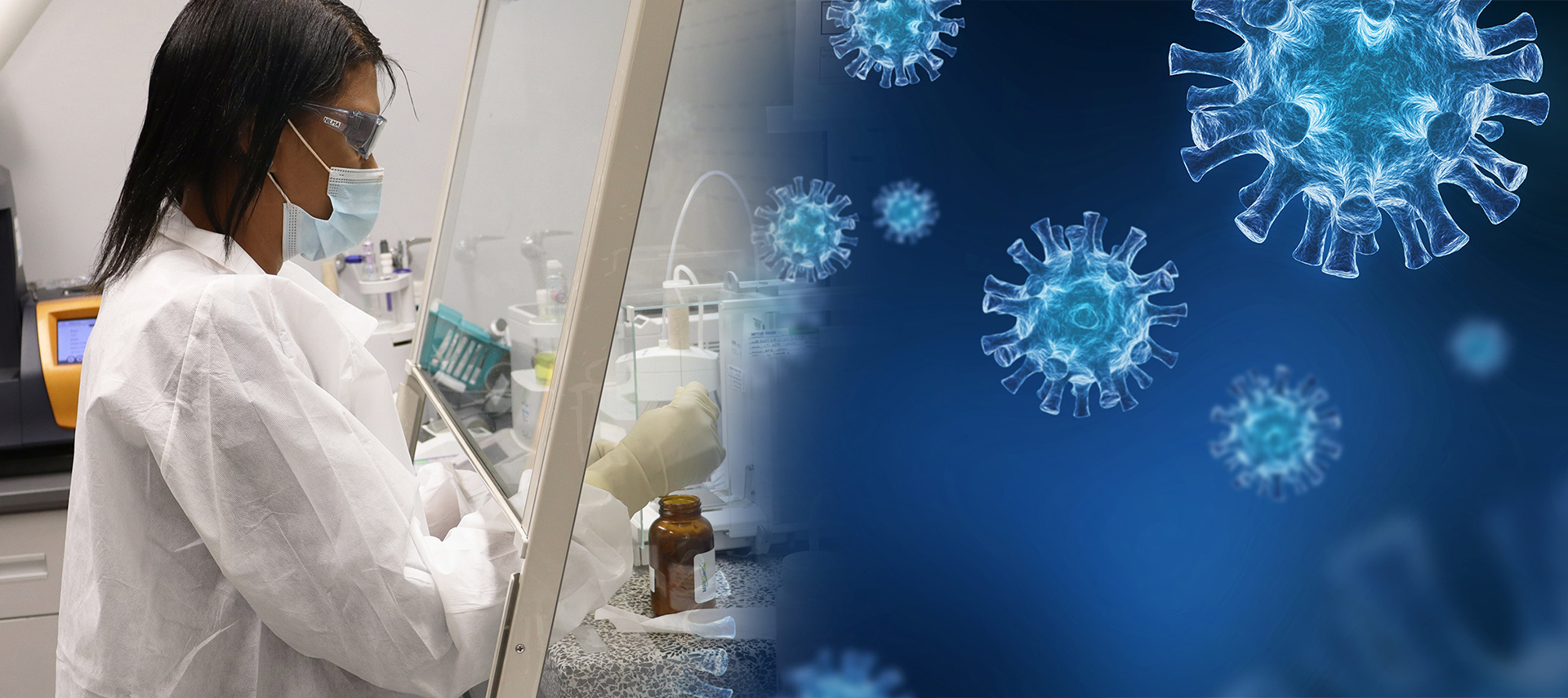Using AI/ML and Team Science to Anticipate and Mitigate Emerging Infectious Diseases Resulting from Climate Change
It’s getting hotter in here. In fact, July 4, 2023 was the hottest day on Earth since at least 1979. Researchers from the World Meteorological Organization recently announced that it’s likely “we will pass the 1.5° C global warming threshold between now and 2027.” One study published by the Yale School of the Environment suggests this “could trigger a cascade of tipping points, which would irreversibly alter the global climate system and further exacerbate warming.” While the resulting impacts are complex, with multifaceted effects, one of those impacts is believed to be the increased incidence of infectious diseases. Through the use of AI/ML as predictive analytics, and a “team science” approach, we can work to mitigate the threat.
Climate change and its effects on infectious diseases are a comprehensive threat to environmental biosecurity, so any mitigation effort must be equally comprehensive. As a result, multidisciplinary engagement and study – team science – across a variety of areas like infectious disease surveillance, animal-human-plant health, ecology, and the environment are necessary.
Our team at MRIGlobal recently collaborated with multinational partners from EpiPointe LLC, CIRMF, UK Health Security Agency, London School of Hygiene and Tropical Medicine, Los Alamos National Laboratory, and the Jacobs School of Medicine and Biomedical Sciences at the University at Buffalo on the paper “Climate Change and Infectious Disease: A Prologue on Multidisciplinary Cooperation and Predictive Analytics,” which was published in Frontiers in Public Health at Frontiersin.org. This paper aims to draw attention to the challenges and necessity of working across multiple disciplines, the role of AI/ML as predictive analytics, five of the diseases tied to climate change, and the importance of collaborative team science. With this understanding, we can enhance our ability to anticipate and mitigate the impacts of emerging infectious diseases.
The Importance of Anticipating Emerging Infectious Diseases
The world’s experience with COVID-19 revealed significant gaps in our past approaches to anticipating emerging infectious diseases. Most past approaches to predicting outbreaks and identifying emerging microbes of major consequence have been with those diseases that cause high morbidity and mortality in humans and animals. Unfortunately, these lagging indicators offer limited ability to prevent disease spillover and amplifications in new hosts.
Alternatively, leading indicators and novel approaches are more valuable in saving lives. Too, they’re now feasible, with multidisciplinary approaches within our grasp to provide links to disease predictions through holistic monitoring of macro- and microecological changes.
Until recently, the variables that truly offer predictive insight into these phenomena have often been difficult to track and manage, let alone analyze in real time. These areas of interest, which are broad across and within disciplines, include studying rapid drug development, genome research, and monitoring of disease vectors induced by climate change. Through the recent application of advances in artificial intelligence (AI) and machine learning (ML) – commonly referred to as AI/ML – in studying microbiology as related to ecology, microbiome, infectious disease epidemiology, and drug discovery, predictive analyses can be more accessible and insightful.
The Use of AI/ML as Predictive Analytics
AI/ML models are generally developed based on data collection, parametrization, and model learning/validation. By collaborating with scientists at local, regional, and global levels, innovations in predictive analytics using AI/ML tools can assess relevant variables of impact, involving processes and algorithms that can simulate human intelligence, including perception, learning, and problem-solving. Their use in data processing can help maximize modern computing resources, with outputs that are algorithmic models uniquely able to handle complex problems with large amounts of data inputs and outputs. Use of AI/ML has shown itself to be invaluable at the intersection of climate change and infectious disease applications in surveillance, prediction, forecasting, research, and development.

Depiction of the AI/ML modeling process. Defining the analysis and function ensures an accurate and precise product.
Infectious Agents Impacted by and Impacting on Environmental Biosecurity
Assuming a One Health view – the approach focused on the “goal of achieving optimal health outcomes recognizing the interconnection between people, animals, plants, and their shared environment” – infectious diseases affect the ecology of hosts, vectors, and pathogens. Diseases like cholera (Vibrio cholerae) and plague (Yersinia pestis) are well studied examples of predictive modeling of waterborne and zoonotic diseases, respectively. Plant diseases caused by pests and microbes impact environmental biosecurity, especially agriculture, and consequently food security across the world.
Recent changes in weather toward warm and humid conditions have favored wheat blast outbreaks, a devastating fungal disease, for example. Schistosomiasis, which is a classic neglected tropical disease caused by freshwater parasitic worms, involves multiple organisms in a habitat where the intermediary snail population is impacted in drier climates and temperature changes. Clearly, infectious diseases that are spread to humans through nonhuman vectors are candidates to spread to new geographic locations based on changes in climate. These changes, currently based on global rises in temperature, will potentially affect the ability of vectors to survive, both increasing and decreasing areas of disease prevalence. Other diseases that are intricately tied to the climate, environment, animal reservoirs, and vectors include Sin Nombre virus, Lyme disease, and others.
Monitoring Disease Vectors and Climate Resiliency
Collectively, vector-borne disease cases have increased by 300 percent in the Americas over the last decade. Despite the already large impact of vector-borne diseases on global public health, morbidity and mortality will likely increase in the coming decades due to a now more rapidly changing climate. Broad changes in temperature, wetness, and vegetation will all affect the prevalence of vectors like mosquitoes and the diseases they carry, driving them into entirely new geographic areas. Weather phenomena induced or exacerbated by climate change often coincide with increases in the activity of disease vectors. For example, floods are some of the most devastating disasters induced by climate change in terms of physical damage and their ability to activate key disease vectors, such as mosquitos and wastewater exposure.
Our colleague Dr. Joseph A. Russell, Ph.D. – an expert in biosurveillance – was recently interested in better understanding whether ticks and mosquitoes had expanded their range and associated vector-borne diseases further north. Working with a team of entomologists and a veterinarian, the group spent time on an island off the coast of Georgia searching for a variety of tick-borne and mosquito-borne pathogens to sample for diseases.
Effectively predicting and monitoring these events is crucial in order to maintain global health. These phenomena are incredibly complex with many factors to consider, but AI/ML can offer a pathway to effectively predict floods and monitor their effects.
The Importance of Genome Research
Genome sequencing is a laboratory method used to understand the genetic makeup of an organism, such as a virus. This type of data can help us understand how a disease works, how to identify it in a human or in the field, and how to best attack it. Understanding genomes has the potential to solve some of the most daunting challenges faced around the world.
A panel discussion was recently published emphasizing the value of genomic sequencing as a tool for addressing climate change and infectious disease with a One Health approach. One particular focus was how organisms shift and evolve during environmental change and its related complexities. When genomic sequencing tools are combined with risk and monitoring management efforts, an effective framework can be designed to illustrate priorities at multiple levels of impact. This combination of multidisciplinary and multi-sectoral resources, as well as advances in predictive analytics using AI/ML tools, offers unique opportunities for effective approaches to exploring these problems.
Environmental disasters in which man-made infrastructures may impact climate factors also influence infectious disease outbreaks from resulting disruption of ecosystems, flooding, contamination, and displacement of human populations. These factors may cause increases (or decreases) in disease transmission, as well as outbreaks that may produce chronic effects over time. Next-generation studies, especially those that identify immediate risk factors and mitigation strategies, combined with rapid genome identification will be increasingly valuable in the future.
Rapid Drug Development
Climate change will affect the behavior and activity of disease reservoirs and vectors such as mosquitoes and ticks. This in turn will increase the likelihood for outbreaks of disease and/or the appearance of novel disease strains. The response to these potential disease events needs to involve a more rapid and comprehensive response than traditional drug development can provide. AI/ML (often referred to in a drug development context as in silico drug development) can provide the tools to overcome this challenge. AI/ML drug development can analyze existing drugs for effectiveness against new disease agent strains, optimize new drugs for desired characteristics such as adsorption, distribution, metabolism, elimination, and toxicity (ADMET), and develop completely novel treatments such as antibodies and vaccines.
A specific example of how AI/ML speeds up the drug development process is demonstrated by the AI/ML biotech firm AbCellera partnering with Eli Lilly to rapidly develop anti-COVID antibody treatments. AbCellera used ML to identify therapeutic antibodies from a convalescent SARS-CoV-2 patient by screening 5.8 million peripheral blood cells (PBMCs) to produce 440 high confidence antibody sequences. ML was further used to select the promising antibodies that appeared in high frequency across the dataset and eventually narrowed down the field to 24 lead candidates that were then tested for in vitro study. The ML process took place in under a month and resulted in the production of LY-CoV555 which showed success in nonhuman primates (NHPs) at neutralizing the virus.
A proactive drug development strategy could also offer a first line of defense against future pandemics. The approach would allow scientists to be ready with an arsenal of drugs that could be quickly moved into clinical trials when a dangerous new infection appears, whether coronavirus or another pathogen. Effective treatments could be made available in weeks, not months or years.
Conclusions – AI/ML and Team Science to Fight Emerging Infectious Diseases
Even under the most optimistic projections, we are faced with a new “non-equilibrium” global health crisis. Climate change clearly impacts infectious disease and biosecurity generally, requiring aspects of biosurveillance, animal-human-plant health, ecology, and environment to be studied in concert. With limited resources and political will, the reactive response posture nevertheless remains a mainstay of the national and international approach to infectious diseases for humans, animals, and plants. Otherwise, the continual reactive response to infectious disease research severely limits our ability to prepare for, detect, and respond to any outbreaks.
A successful top-down approach requires unprecedented national multiagency to multi-sectoral and multidisciplinary cooperation. Climate change does not choose ownership, so this challenge requires worldwide contribution and engagement. On one hand, the COVID-19 pandemic demonstrated intergovernmental and multinational cooperation to an urgent and compelling extent, but, at the same time, climate change is so complex that future challenges may neither be evident nor approachable with current tools.
By harnessing innovations in predictive analytics using AI/ML tools, coupled with multidisciplinary and cooperative “team science,” we can enhance our ability to anticipate and mitigate the impacts of emerging infectious diseases.
GETTING STARTED AT MRIGLOBAL
Contact MRIGlobal for further information about our work with infectious diseases. Through an interdisciplinary approach, we provide scientific and subject matter expertise for development of medical countermeasures research against specific threats, while expanding and accelerating the delivery of high quality clinical diagnostic products.
To discuss how we can help your project be successful, contact us today.
SIGN UP FOR OUR NEWSLETTER
Sign up for the MRIGlobal newsletter! It’s the best way to get the latest updates in the world of applied scientific engineering research delivered directly to your inbox.

